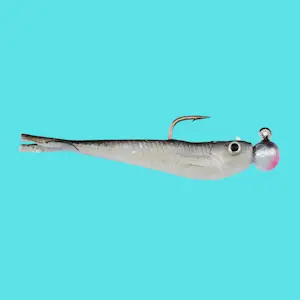The 7 Best Perch Rigs (Rigging & Fishing Guide)
UPDATED 03 NOVEMBER 2023
by Robert Ceran
While small perch are usually easy to catch (and abundant in most lakes), bigger perch over 1 to 2 pounds are much harder to target, and require more skill from the angler.
But no matter if you want to catch your limit of panfish-sized perch, or if you want to hook a trophy perch or two, it’s essential to know what rigs to use for perch fishing, in order to improve your chances of success.
Here I’ll cover the best perch rigs that you need to know. I’ll also discuss how to tie each of them, how to use them, and what purpose each of them is ideally suited for.
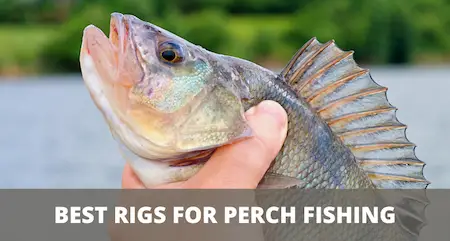
How do you rig for perch fishing?
The best perch fishing rigs are:
- Jig rig
- Slip bobber rig
- Drop shot rig
- Ned rig
- Carolina rig
- Perch pounder rig
Each of these perch rigs comes with its own set of strengths and weaknesses, and we’ll walk you through each of them below.
We’ll also give you a recommendation on what these perch fishing setups are best suited for, so you can decide which rig is best for you.
Jig rig

This is by far the easiest perch rig to tie, and is usually worth trying out first, since it allows you to get a sense of what the fish are keyed into before you try more complex perch fishing setups.
How to tie it: If you’re using fluorocarbon or monofilament as your main line, you don’t need to tie a leader, and can just tie your main line directly to a 1/8 to 1/4 oz jig head (either plain metal, or a colored jig head is fine).
But if you’re using braid as your main line, you’ll need to tie a 2 foot long 6 to 8 lb test fluorocarbon leader.
After tying the jig head to your line, thread on a soft plastic lure, such as a grub tail or paddle tail swimbait. Personally, I like to use Berkley power minnows with this rig, since they have the perfect action.
Another great thing about this perch fishing setup is that you can easily switch out the soft plastic lure to test different shapes, sizes, and colors.
How to use it: As with all yellow perch rigs, you should aim to keep them very close to the bottom during retrieval.
So after casting your jig with a jigging rod, wait for it to reach the bottom before you start retrieving it, and regularly pause during retrieval to let it sink back to the bottom.
Experiment with different retrieval speeds and cadences, until you find something that triggers bites.
When to use it: The jig rig is a great search bait, which you can use to cover a lot of water in search of feeding perch.
It’s also a great option if you’re not getting any bites on a live bait rig, or if you’re not sure if there are any fish around.
Keep on moving around until your find a school of fish, and then experiment with different baits and presentation techniques.
Slip bobber rig
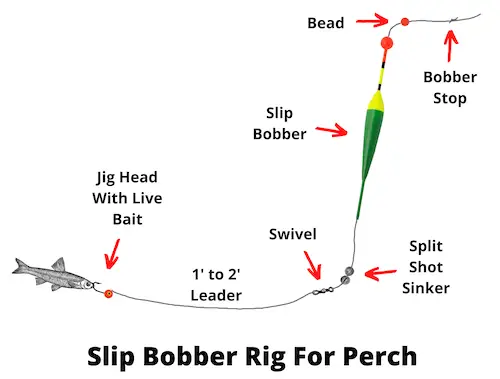
This is one of the best perch rigs for live bait, and also one of the best setups to use from shore. I like to set up a deadstick with a slip bobber rig, while casting a lure with my active rod.
How to tie it: It’s best to start by threading a bobber stopper onto your line, followed by a plastic bead (which prevents the bobber stop from getting stuck inside the bobber), and then the slip bobber.
Since perch don’t respond well to a lot of resistance when they take a bait, it’s best to use a relatively thin finesse bobber when fishing for perch.
Underneath the bobber, pinch on some split shot weights to stop the bobber from sliding down all the way, and then tie the line to a swivel.
Finally, tie a 6 to 8 lb test fluorocarbon leader to the swivel, and a size 2 to 4 bait hook (or micro jig head) to the other end of the leader.
How to use it: When using the slip bobber rig, it’s important to adjust your depth setting to about 6 inches above the bottom, since this is the primary strike zone for perch.
Once you’ve determined the right depth, bait the hook with a minnow or a worm, cast out your perch live bait rig, and wait for bites.
When to use it: This perch float rig is a great option to use from shore, since you can cast it out and wait for fish to pass by and take your bait.
You can also use this perch bait rig from a boat, but keep in mind that if you’re drifting, the depth of the bottom will tend to change all the time, which makes it harder to keep your bait presentation close to the bottom.
Drop shot rig for perch
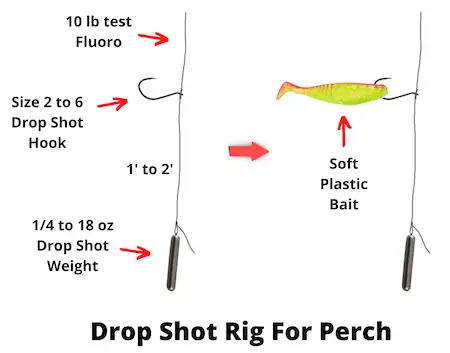
The drop shot rig was originally developed as a finesse rig for bass, but has now become one of the most popular perch rigs, since it provides anglers with an amazingly sensitive and lightweight presentation that targets exactly the right depth of the water column.
How to tie it: Start by tying a size 2 to 6 drop shot hook to your line (here’s a great video tutorial on how to do that). Next, clip on a 1/4 to 1/8 oz drop shot weight to the line underneath the hook, and then add a soft plastic bait to the hook, as shown in the image above.
One of the advantages of this perch rig setup is that you can adjust the position of the weight on the line, which allows you to easily change the depth of your bait presentation.
How to use it: Cast out your rig, and wait for the weight to sink to the bottom. Then use subtle movements of your rod tip to twitch the lure without actually lifting the weight off the bottom.
Do this for a couple of minutes in each spot before reeling in a few feet of line and repeating the process.
When to use it: The drop shot rig is great when you’ve found a location with lots of fish, since it allows you to fish in one spot until you get a bite, without having to continuously retrieve the lure.
It’s also great because you can key in on a very specific depth where perch are active.
Ned rig
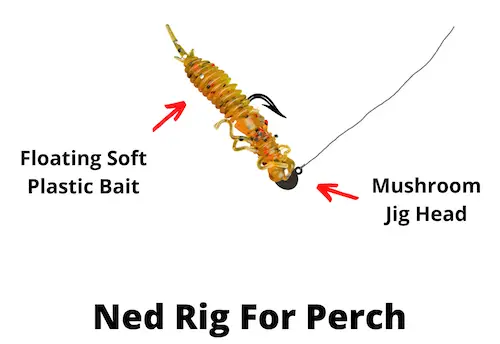
While the ned rig superficially resembles the jig rig, it has a different and very characteristic action in the water, which makes it highly effective for catching perch.
How to tie it: Tie this perch rig the same way that you would tie a jig rig, but using a mushroom jig head instead of a regular round jig head.
Also, when choosing a soft plastic bait to use with the ned rig, it’s essential to choose one that is specifically designed for ned rigging, and that floats in the water.
How to use it: Cast out the ned rig, and retrieve it slowly, pausing for a few seconds every time the ned rig reaches the bottom.
The distinguishing feature of the this yellow perch fishing rig is that the combination of using a mushroom jig head with a floating plastic bait results in its tail standing up straight every time you let the ned rig sink to the bottom.
Perch seem to find this action irresistible, and you’ll often experience getting bites when your jig is sitting on the bottom.
When to use it: You can use this perch rig as a search bait setup, or you can use it on finicky fish that don’t respond to other presentations. It’s especially effective when the perch are pressured, and if they’re not used to seeing a ned rig.
Carolina rig
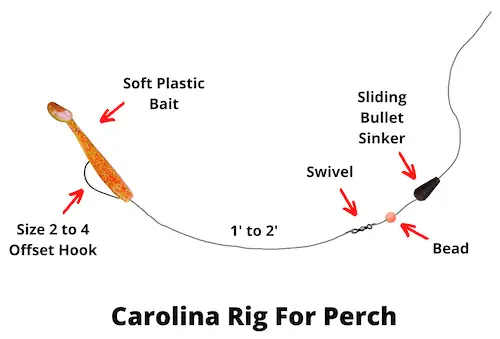
The Carolina rig is one of the most versatile bottom fishing rigs in the world, and works well for a variety of species, including perch.
How to tie it: Thread a bullet sinker onto your main line, followed by a plastic bead, and then tie your line to a swivel. The plastic bead prevents the weight from getting stuck on the swivel, or damaging the knot.
Next, tie on a 1 to 2 foot fluoro leader, and they tie that to a size 2 to 4 worm hook, which is designed for weedless rigging of a soft plastic bait. You can choose from a wide variety of soft plastics, including minnow, shad or worm imitations.
How to use it: Cast this perch rig setup out and wait for the weight to reach the bottom. Then give it another 10 to 20 seconds before reeling in a couple of feet, and pausing again.
Every time you pause this perch rig, the plastic bait (which doesn’t have any weight except the hook) sinks slowly down towards the bottom, and this is usually what triggers bites.
Perch bites on the Carolina rig can be quite subtle, so you really need to pay attention to soft taps or tugs. If you do feel a bite, reel in until you feel resistance, and then set the hook.
Braided line is the best choice as your main line for this perch rig, since it provides the most sensitivity in terms of being able to feel what’s going on with your hook and sinker.
When to use it: the Carolina rig is a great option for fishing from shore or from boat, and I like to use it when yellow perch aren’t responding to other presentations, since this rig can trigger bites from finicky pressured perch.
Perch pounder rig
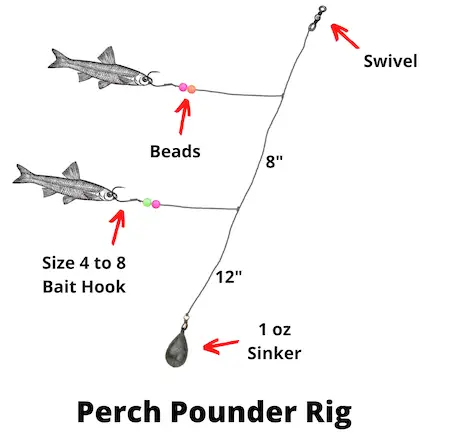
The perch pounder rig is ideal for vertical fishing from a boat, and works best in relatively deep water.
How to tie it: Use one piece of leader line to tie the entire rig. Since you don’t want the side arms of this perch rig to constantly get tangled up with the main line, it’s best to use a relatively heavy fluorocarbon line of about 15 to 20 lb test, which is quite stiff.
Tie a loop in the leader line by folding a loop back on itself and then tying several overhand knots.
After pulling this tight, cut one of the arms of the loop, which results in a straight piece of line sticking out from the leader.
Thread one or two beads onto this line, and then tie on a size 4 to 8 bait hook.
Next, repeat this process by tying a second loop about 8 inches below the first loop, and also add beads and a bait hook to this one.
Then cut off the leader line about 12 inches below the second hook, and tie it to a heavy 1 oz sinker.
In the last step, cut off the leader above the top hook, and tie it to a swivel, which you can use to tie it to your main line.
How to use it: The best way to use this perch rig is for vertical fishing from a boat in deep water of 50 feet or more, and it is one of the best rigs to target big perch in this kind of setting.
Bait the two hooks with live minnows (which is why this perch rig is also known as the ‘double minnow rig’), and lower the rig down to the bottom from your boat.
When you find a big school of yellow perch, it’s not uncommon to get double hook ups with this perch rig.
When to use it: The perch pounder rig was originally developed for catching perch in deep water in the great lakes, where conventional setups don’t work so well.
However, it works just as well in any lakes that have deep water where big schools of perch like to hold, and since it’s designed for vertical fishing, it makes a great ice fishing rig for perch as well.
What is the best perch rig?
The best perch rig is the drop shot rig, since it is an ideal all-around setup for targeting perch with a lightweight lure or bait presentation close to the bottom.
Unlike bass, perch tend to require more finesse (especially in pressured lakes), which explains why the drop shot rig is so effective for catching them.
Another advantage of using a drop shot setup is that you can use this rig for both vertical fishing from a boat, or for casting from shore.
With that being said, each of the perch rigs discussed above can be the best option to use in some circumstances. Also, keep in mind that the simplest rigs are the jig rig and the Ned rig, which are therefore great options to use as search baits to find schools of fish.
Once you find a good spot with a school of perch, you should then go on to experiment with the other perch rig setups, in order to find what rig works best for you.

